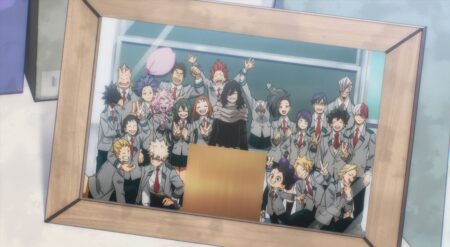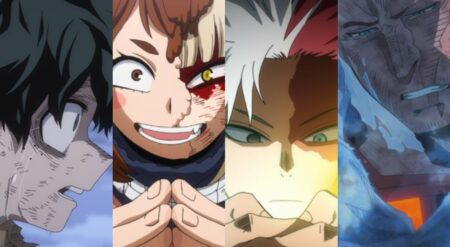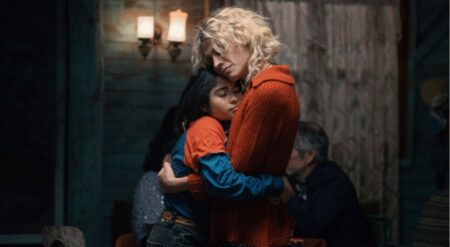After years of flying under the radar, Hell is Us is finally stepping into the light—and what it reveals is something strikingly bold. Developed by Rogue Factor and led by industry veteran Jonathan Jacques-Belletête (Deus Ex), the game blends a bleak civil war setting with haunting supernatural elements in a world where player agency and mystery reign supreme.
I had the chance to preview the game and sit down with Jacques-Belletête (Creative Director), Yves Bordeleau (Studio Head), and Antoine Vachon (Audio Director) to talk about their creative philosophy, the studio’s all-in-house approach, and what it means to build a modern game with a ‘90s soul.
What followed was one of the most honest and passionate developer conversations I’ve had in a long time.
Interview edited for brevity and clarity.
BUT WHY THO: The first thing I noticed in the game is that it’s gorgeous. It’s bleak and dark, but also beautiful. There’s a subtle beauty throughout. You can see it in the culture of the people and the environment.
When I went into the dungeon level, that open canyon with all the flowers? “Pretty” was not what I expected. Can you talk to me a bit about the art direction? Why go with something dark and gritty, but still beautiful?
Jonathan Jacques-Belletête: We need moments of respite, yeah? Amid all that gloominess. There’s a civil war taking place, and like we said earlier, it’s a hermit state. It’s been closed off from the world for a long time. The game takes place in 1993, but the country is even further behind than that, like many hermit states are.
Visually, it’s gloomy because of the civil war and everything going on. But we still needed to create moments of light through all that darkness. That contrast was important. And there’s a strong throughline in the art direction: topography. All those terrain lines—the ones that show up on enemies, on weapons—that’s intentional. There are lore reasons for it that you’ll uncover as you play.
Like you said, when you arrive at the lake, where you open the dungeon, it’s one of those areas where it’s like, “Whoa, okay.” It’s sunny. There are flowers. It’s peaceful. Things happen there—things I won’t spoil—but yeah, it’s a contrast.
Also, time plays a role in the game, not in the sense of a ticking clock, but in how events play out over time. People move. NPCs change. Depending on how you interact with certain characters or solve certain mysteries, a place like the lake can feel very different—more joyful, even.

BUT WHY THO: That makes sense. And on that note, no quest markers, no traditional UI, but it still felt easy to get around. I didn’t feel lost. Can you talk a little about the philosophy behind that? I think you called it “player-plattering?”
Jonathan Jacques-Belletête: So, the idea is, we don’t hand everything to you on a silver platter. You build your own plate. That’s where the term comes from: player-plattering. You collect your own ingredients and figure out how they go together. This is something I had been thinking about for a long time—even before we sat down to make this game. It’s about player agency. It’s about the idea that the world should tell you what to do—not a marker, not a checklist.
In most modern games, the art is there just to be pretty or to set the tone. But it rarely communicates function. In the ’90s, games didn’t have markers either, but we were limited visually. We couldn’t guide the player the way we can now. Now we have every tool available. So the question was: what happens when you try to do it this way? Can we let the environment guide the player? Can we make sure the NPCs are giving you real clues if you’re paying attention?
And to do that, the dialogue had to be tight. Very succinct. The way the dialogue UI is structured, you’ll notice the left side usually gives you useful, actionable information. The right side? That’s more thematic. It’s people talking about what they think, how they feel.
But the clues are short and buried in the main text. It’s intentional. Because in other RPGs, NPCs just talk and talk and talk and it doesn’t matter, because when they’re done, a marker shows you exactly where to go. You don’t need to listen.
“But in Hell is Us, you have to listen. And that’s why the lines are short and to the point. They matter.” – Jonathan Jacques-Belletête

We also leaned into using the world itself as your guide. Not a magical compass that points you where to go, but actual cardinal directions—north, south, east, west. We made sure things in the environment stood out. There are subtle cues, some you might not even notice at first, that are actually guiding you. And a lot of those cues aren’t even visual. Some are audio.
It was a learning curve, but honestly? Pretty early on, it started working. People would playtest and immediately latch onto it. Even before combat was fully fleshed out, the exploration and player-plattering stood out. And we thought, okay—we’ve got something here.
BUT WHY THO: Are there secrets that people still haven’t found? Like things you’re just waiting for someone to uncover?
Jonathan Jacques-Belletête: Oh yeah. There are definitely some secrets that haven’t been discovered yet. The way we approached it, we tiered them. We have four tiers.
Tier 1 is easy, obvious stuff. Tier 4? That’s the really hard stuff. We actually labeled it “Reddit” in our documentation. That tier is the kind of thing we expect people to crowdsource together to figure out.
Yves Bordeleau: There’s something beautiful about that, too. About not having everything show up in a guide right away. These days, it feels like a trophy guide is live before the game is even out. We wanted to bring back some of that sense of discovery.
Antoine Vachon: And we tried to reflect that same idea through audio. There are sound cues in the world that are meant to make you stop and ask: “Why is that here? Is this telling me something? Is it a clue? Or is it just environmental?” That mystery, where you’re not quite sure if it’s a hint or not, is something we tried to build into all aspects of the design: sound, visuals, story.
Jonathan Jacques-Belletête: Exactly. Now that you mention it, sound is a part of the player-plattering system too. Like the wind chimes early in the game. That’s a simple but elegant example. We’re teaching the player that listening matters. That some of the breadcrumbs are audio, not just visual.

BUT WHY THO: Can you talk more about the audio design? Because I thought it was incredible. Even things like the pattering of rain, or how the controller vibrates with the sound instead of just reacting to your actions—it felt really immersive. The voice acting too—it’s fantastic.
Antoine Vachon: Thank you. That means a lot. We worked really hard to make each area sound unique. When players enter a new map or zone, we want them to feel that shift through sound. That means different ambient textures, different emotional tones. You should be able to tell you’re somewhere new—not just by sight, but by ear.
We tried to make every sound cue mean something. It might hint at what’s coming. Or it might tell you what kind of emotion is in the air. That same philosophy goes into the voice acting too. We don’t overload areas with NPCs, but the ones that are there? They matter. They’re survivors for a reason.
Jonathan Jacques-Belletête: Rémi, the protagonist, has this arc where he evolves as a person through those conversations. Sometimes it’s small—a side character you help. Sometimes it’s more central. But you can see that emotional development, especially in how he interacts with the people he meets.
Antoine Vachon: We had a fantastic cast. Rémi is voiced by Elias Toufexis, who played Adam Jensen in Deus Ex. He’s also been in Star Trek and a ton of other stuff. He brought incredible depth to Rémi’s journey.
And then there’s Patricia Summersett—she’s the voice of Zelda in Breath of the Wild. She plays one of the major characters in the game. I won’t say who, because we want to preserve some mystery, but her role is big.
Jonathan Jacques-Belletête: Antoine and Elias also came up with a really cool detail for the dialogue. When you meet a major NPC for the first time, you don’t know their name. It shows up as a question mark—just like in real life. And the first line Rémi says is usually “Who are you?”
But they recorded dozens of different versions of that line depending on the emotional tone of the interaction. Sometimes he’s calm. Sometimes suspicious. Sometimes more vulnerable. That level of subtlety adds so much.
Antoine Vachon: And every single line of dialogue in the game is voiced. Fully voiced NPCs. No silent filler characters. It was all recorded in-house.
“[Hell is Us] was the hardest game I’ve ever worked on.” – Jonathan Jacques-Belletêt

Yves Bordeleau: That was important to us. When we moved into this studio space, we planned around doing everything in-house: voice recording, music, mocap—even that demo room you played in, that’s also our mocap space.
Jonathan Jacques-Belletête: And yeah—our composer (Stéphane Primeau) is also in-house. That’s almost unheard of in AAA. Normally, you hire someone per project, they do the score, and then they move on.
Antoine Vachon: But having a composer in-house lets us design not just tracks, but musical systems. We have thousands of adaptive transitions. The music reflects what you’re doing, where you are, what you’re feeling. And being able to fine-tune that in real time, in the same building—it’s a huge win.
Yves Bordeleau: Funny story—our composer, Stéphane, has been working with me since 2004. We met when we were both touring with our metal bands. I gave him his first gig writing game music, and he’s been part of every studio I’ve run ever since.
Antoine Vachon: There’s more music coming in the full game too. What you’ve heard is just the beginning. Later on, things get… interesting.
BUT WHY THO: Let’s talk combat. I jumped into the dungeon section during the preview, and wow—those enemies are intense. I’m not a horror person, so I hated them, in the best way possible. How did you come up with their design?
Jonathan Jacques-Belletête: There are two core entities in the game: the Hollow Walkers and the Haze. Not all Hollow Walkers spawn Haze, but when they do, that’s where the challenge and the weirdness kick in.
The Haze is a physical manifestation of a human emotion—rage, grief, terror, ecstasy. These four core emotions are placed on a kind of grid: rage vs. terror, grief vs. ecstasy. The Haze is raw emotion, but it can’t move on its own. Think about it. If you’re angry in the morning, your anger doesn’t get in the car and go to work. You do. You carry it with you.
That’s what the Hollow Walker does. It’s the husk of a person who once felt something so overwhelming that the emotion became a separate entity. The umbilical cord you see between them is intentional. The Hollow Walker is the anchor. The Haze is the force.
And we went through a lot of visual iterations. At first, the Haze designs were more organic. But in a third-person camera with melee combat, it just didn’t read. The details got lost. So we shifted toward something more abstract—cosmic, geometric, almost otherworldly. They scream like humans, but they’re not human. And that creates discomfort.
Rogue Factor explains how they reshaped the idea of exploration in Hell is Us.

BUT WHY THO: That makes sense. I jumped into the Forge dungeon, and I had access to a lot of powers. But if someone’s playing from the beginning, how do you make sure they’re not overwhelmed?
Jonathan Jacques-Belletête: Yeah, totally. If you’re playing the game from the start, by the time you reach the Lymbic Forge, you’ve already gone through a major map and an investigation that loops you back through previous areas.
During that journey, you meet Victor, the tinker. You find him in a tunnel, bring him back to the village, and he becomes your blacksmith. He helps you upgrade your gear. You do the glyph application yourself, but he upgrades your weapon stats so they can grow.
And we pace everything out. You don’t get all the glyphs at once. You collect them gradually. Some glyphs are emotion-specific—like you can only put grief glyphs on a grief-aligned weapon. Same for ecstasy. That naturally guides your build path and lets you experiment in a controlled way.
You also learn by doing. You test things out, combine different glyphs, try different playstyles. It becomes very personal. We didn’t want a system that dumps 20 tools on you and says, “Go.” We want you to earn them. Understand them.
Yves Bordeleau: We had fun internally comparing builds. Everyone played differently. Some focused on range, others on buffs, others on raw power. That’s where the fun is: figuring out what works for you.
Jonathan Jacques-Belletête: It’s kind of like Final Fantasy, right? You get a new spell, and you’re like, “What does this do?” And you learn through repetition. That’s how the glyph system works here.
BUT WHY THO: Final question, what did each of you learn about yourselves as developers while making Hell is Us?
Antoine Vachon: It’s hard to face the darkness of humanity. I’ve worked on a lot of colorful, cartoony games. This wasn’t that. This was intense. It made me think a lot—about what we’re capable of, how we process emotion, what trauma looks like. It shocked me sometimes. I had to be careful. Protect my own emotional state. You don’t realize how heavy some of this stuff is until you’re deep in it.
Jonathan Jacques-Belletête: There were parts of the game where I had to stop and ask the team, “Are you okay with this?” Like, we show a lot of dead bodies. We even studied what corpses look like under certain conditions. I had to check with our character artists—are you okay creating this? That stuff adds up. But we also balanced it with dry humor and lighter moments. The game isn’t all doom. Still, it’s a heavy ride.
Hell is Us brings a darkness that the Rogue Factor developers needed to ensure didn’t take its toll.

Yves Bordeleau: It made me reflect a lot. The game is literally about emotions. Through Rémi’s story, you see how emotion changes people. And I had moments during development where I thought, “Damn. I’ve felt like that.” One scene hit especially hard. I won’t spoil it, but it brought back something real from my own life. And that helped shape the way we told certain stories in the game.
Also, when we announced Hell is Us, it was the same month the war in Ukraine started. I called a friend in Kyiv and asked, “Should we delay this? Is it disrespectful?” And he told me, “Don’t hold back. Be honest. War is war.” That really stayed with me.
Jonathan Jacques-Belletête: This was the hardest game I’ve ever worked on. We started from nothing. Blank page. The way I describe it is: you have all the atoms in the universe—how do you combine them to build something meaningful?
I had two kids during development. We went through COVID. We pivoted the entire studio. Built a new team. Changed direction. It was intense. But I learned that if you believe in what you’re doing—like truly believe—there’s always energy left. Even when you think you’ve hit the wall, there’s still something in the tank.
Yves and I, we’d hit some big walls. And we’d go to our favorite steakhouse, sit down, eat a massive meal, and say, “Okay. How do we fix this?” And somehow… we always found a way.
What makes Hell is Us so compelling isn’t just its brutal beauty, layered combat, or even its Reddit-tier secrets. It’s the clear love and intention poured into every piece of it. Rogue Factor isn’t chasing trends or fast wins.
They’re crafting a game that asks more of its players—and gives back just as much. If the preview and this conversation are anything to go by, Hell is Us is shaping up to be one of the most unforgettable and uncompromising games of the year.
Hell is Us is set to release on September 4, 2025, for Windows, PlayStation 5, and Xbox Series X/S.






![[EXCLUSIVE] ‘Invincible VS’ Devs Dive Deep Into Their New Original Character: Ella Mental Ella Mental in Invincible VS](https://butwhytho.net/wp-content/uploads/2025/12/Invincible-VS-Ella-Mental-But-Why-Tho-1-450x247.jpg)